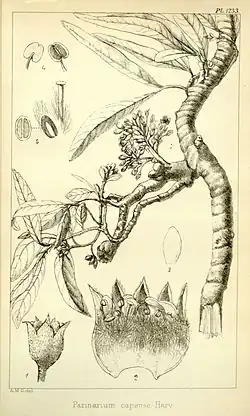Parinari capensis
| Sand apple | |
|---|---|
.jpg)
| |
| foliage and inflorescences | |
| Scientific classification | |
| Kingdom: | Plantae |
| Clade: | Tracheophytes |
| Clade: | Angiosperms |
| Clade: | Eudicots |
| Clade: | Rosids |
| Order: | Malpighiales |
| Family: | Chrysobalanaceae |
| Genus: | Parinari |
| Species: | P. capensis
|
| Binomial name | |
| Parinari capensis | |
| Synonyms[1] | |
| |
Parinari capensis, the sand apple, is a species of flowering plant in the family Chrysobalanaceae.[1][2] It is found in Botswana, DRC, Mozambique, Namibia, South Africa, Tanzania and Zimbabwe. It is 20 centimetres (7.9 in) tall. The leaves are elliptic with a white underside. It has small white flowers and a hairy sand-coloured calyx.[3]
Habitat

The species can be found on sand, in open woodland and grassland on the elevation of 1,200–1,600 metres (3,900–5,200 ft). It blooms from September to October.[3] The species is considered a geoxyle with a substantial part of the plant growing under the ground, an adaptation to fire-prone habitats. They have been considered therefore as forming immortal underground forests of great age.
Uses
The plant is used for anti-malaria purposes.[4]
References
- ^ a b "Parinari capensis Harv". Plants of the World Online. The Trustees of the Royal Botanic Gardens, Kew. n.d. Retrieved November 27, 2024.
- ^ "Parinari capensis Harv". Catalogue of Life. Species 2000. n.d. Retrieved November 27, 2024.
- ^ a b "Parinari capensis". Flora of Zimbabwe. Retrieved April 7, 2013.
- ^ Uys AC; Malan SF; van Dyk S; van Zyl RL (August 2002). "Antimalarial compounds from Parinari capensis". Bioorg Med Chem Lett. 12 (16). Potchefstroom University for Christian Higher Education: 2167–9. doi:10.1016/s0960-894x(02)00350-5. PMID 12127529.